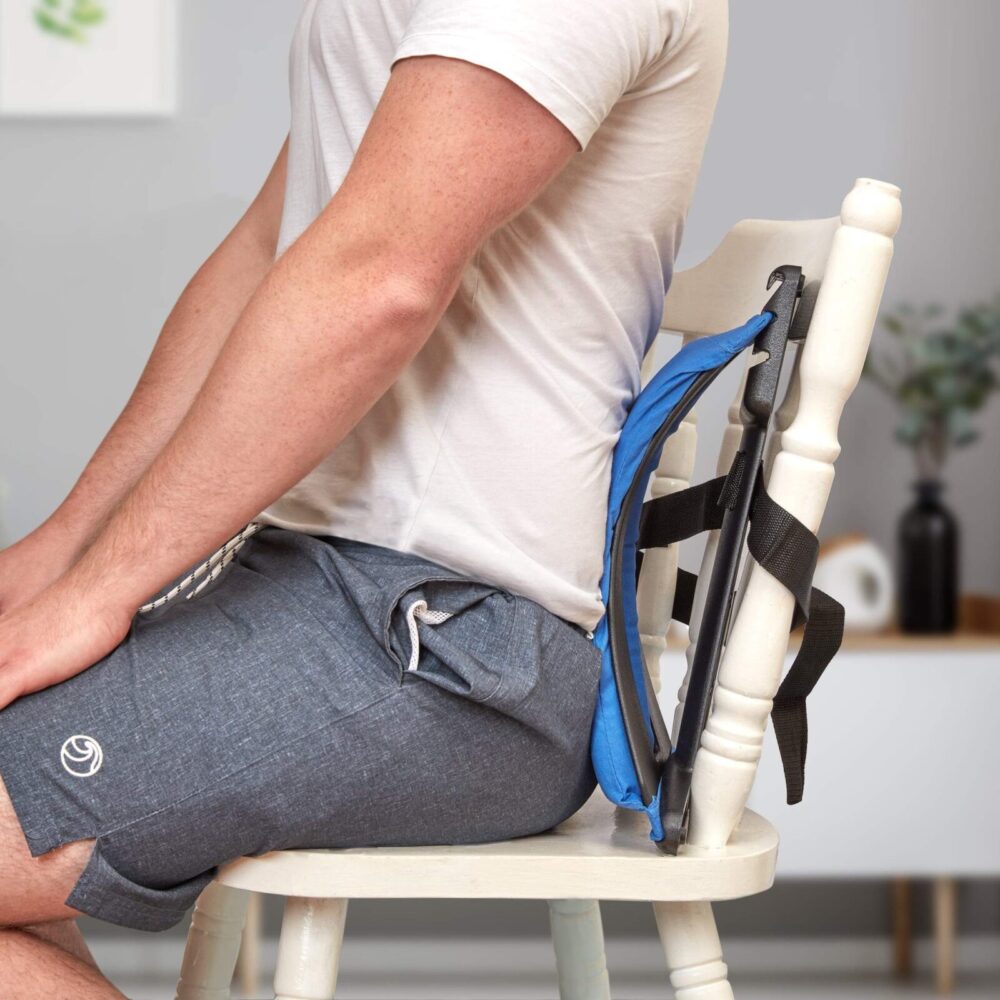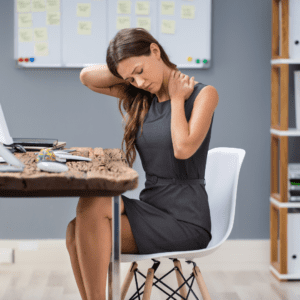Just how Bad is sitting for your back health?
We’ve all heard that we should sit tall and keep our shoulders back for optimal alignment. But why is sitting posture so critical and what happens to our bodies if we sit for too long or adopt a poor sitting position? In this article we’ll look at some of the negative effects of sitting and how we can offset these to make sure our long-term health isn’t negatively impacted.
So what exactly is the optimal sitting position to make sure we don’t get any postural in-balances? Well according to the health professionals there are some key steps we need to adopt.
- Ensure your bottom is pushed all the way to the back of the chair before sitting up. This makes sure that your hips are correctly aligned and ensures your weight is being supported correctly by your pelvis. If you, like many sit with your bottom further forward this means your weight is being supported by your tailbone which immediately causes the rounding of the back and has a chain reaction on the alignment of your upper body. Adopting this first step is perhaps the most crucial as all the elements that follow will occur more naturally.
- Ensure your knees are at right angles and your feet are flat on the floor. This prevents pressure from building up under your thighs which will tighten your hamstrings and put added pressure on your lower back. It may be necessary to use a foot stall or a height adjustable chair. Crossing of the legs is also a bad idea as this will tilt your pelvis again adding pressure to the muscles in your lower back.
- Ensure your spine is neutral. This means that all 3 natural curves of the spine should be present. You may benefit from the addition of a Lumbar Support which will ensure the curve of your lower back is present and supported.
- Your shoulders should be back and your neck and head straight. If you feel yourself slouching then consciously pull your shoulders back into position. The addition of a posture corrector will actively hold your shoulders back which may help you with this. If you’re working at a computer raise the height of the screen to eye level to ensure you don’t need to strain your neck.
- The next step is again perhaps one of the most crucial. Ideally you shouldn’t sit longer than 30 minutes without getting up and moving. Movement is key if you want your body to remain flexible and supple. If we stay inert for extended periods of time, regardless of the position our bodies will become sore and stiff. Of-course this isn’t possible for everyone. Many of us have jobs which will prevent you getting up and moving around every 30 minutes. So what do we do if this is the case? Read onto find out how we can offset the effects of sitting.
Before we delve into the depths of how we can prevent sitting from negatively impacting our wellbeing, what exactly does sitting do to our bodies in the long term. Let’s look at some of the things which could happen if we don’t take a proactive approach.
- Weak Legs and Glutes. Like any muscle if you don’t use it you will eventually lose it. Muscle atrophy can occur if we don’t actively engage our muscles. Our Legs and Glutes play a very important role in creating the foundations for the rest of our body. Having weak glutes will mean more pressure is put on your lower back, leading to lower back pain and a higher risk of injury.
- Stiff Shoulders, Neck and Chest. If you sit with a poor posture and are hunched over a computer screen, your shoulders will round, your neck will strain and there will be an increased pressure on your sternum. This can lead to conditions such as Costochondritis which is an inflammation of your cartilage in your breastbone.
- Weight Gain. This is perhaps no surprise! If we live sedentary lifestyles and don’t burn our daily intake of calories weight gain will inevitably occur. Studies have shown that prolonged sitting causes fat to build up around the middle which is the worst place to store fat. Excess weight means excess pressure on your muscles and joints particularly the lower back.
- Tight Hips and Pelvis. When we sit our hip flexors which are the muscles that run down the front of our legs shorten. This causes our pelvis to rotate anteriorly, to maintain balance your spine has to compensate for this meaning the discs in your lower back will be compressed which can lead to premature disc degeneration and chronic pain.
- Anxiety and Depression. The mental effects of back pain are well known and documented. Chronic pain and depression go hand in hand and once the cycle has begun it becomes very hard to break. Because back pain is rife amongst those who sit for excessive periods of time, so too is an increased incidence in depression and anxiety.
- Studies have shown that Sitting and more specifically sedentary behaviour will increase your chances of developing severe disease such as certain types of cancer { https://blogs.bmj.com/bjsm/2015/01/21/sitting-ducks-sedentary-behaviour-and-its-health-risks-part-one-of-a-two-part-series}, heart disease { https://journals.lww.com/acsm-msse/Fulltext/2010/05000/Sedentary_Behaviors_Increase_Risk_of.6.aspx} and diabetes.
- Varicose Veins and Deep Vein Thrombosis. Sitting for long periods of time will cause your blood to pool in your legs which can cause varicose veins and in more serious cases Deep vein thrombosis.
Now that we’ve read the scary stuff, how exactly can we prevent them from happening? The good news is that through some simple steps we can make sure that our back health and overall wellbeing is maintained.
We’ve already mentioned some tips on how you can improve your sitting posture and also some useful aids that can help support you, but below is a definitive guide on how to keep your posture and back pain in check.
- Chose the right chair. Now this may seem obvious, but what exactly is the right chair? Well firstly you want a chair with adjustability, unfortunately it’s not a one size suits all kind of thing. Our backs are like our personalities and therefore one chair position may suit one person but not another. At the very least the chair should have a vertical adjustment, a lumbar adjustment and an ability to recline. A recline ability I hear you say….aren’t we all meant to sit upright? Well contrary to popular belief the research would suggest otherwise. Whilst sitting upright perhaps on a yoga ball or kneeling chair is good for core strength…it’s not so good for your back pain. Numerous studies have found that sitting upright say on a kitchen chair or non adjustable office chair increases pressure on your discs by more than 40% in comparison to sitting in a reclining chair. The university of Alberta found that the optimum angle of reclination is 135 degrees, now this may not be ideal for sitting at a desk so 110 degrees was found to be almost as effective in reducing back pain.
- Lumbar Support. Following on from the above, a Lumbar support is crucial in reducing back pain as it gives your back added support and reduces the pressure on your discs. Choosing a chair that has an adjustable lumbar support would be wise, but alternatively you can buy portable lumbar supports and cushions. Research has found that external lumbar supports with a cut out design improved the comfort in both healthy individuals and those who suffer from lower back pain.
- Use a posture corrector to keep your head shoulders and neck in alignment. Its easy to slouch and hunch over a computer screen or mobile phone after a period of sitting. With the best will in the world even the most determined of us will eventually lapse and fall into a slouching position. According to Dr Kenneth Hansraj a head weighs 12 pounds on average at a 90 degree upright angle, but at a 30 degree angle this weight increases to the equivalent of 40 pounds. This increased weight plays havoc on your back pain and if such habits are left unchecked long term postural imbalances will eventually occur. A posture corrector will keep your shoulders back and will prevent you from hunching forward whilst sitting at a chair.
- Counteract all that sitting. The last thing many of us want to do when we get home from work is to exercise. But counteracting all those hours of sitting is absolutely crucial if we want to maintain a healthy posture and wellbeing. Overtime unless offset, certain muscles will become weaker whilst others become shorter which puts more pressure on our joints. With some targeted posture correcting exercises we can make sure we stay in balance. Below are 3 simple stretches that can help offset all that sitting.
3 Simple Exercises to Offset all that Sitting
Lengthen Those Hip Flexors.
The Hip flexors are a group of muscles which run down the front of your leg and attach to your pelvis. If we sit for excessive periods of time, these hip flexors will shorten. This results in the shortened hip flexors pulling on your pelvis, rotating it anteriorly. A pelvis which is anteriorly rotated causes excessive pressure on your back as well as tight hamstrings and a range of other postural imbalances. Some people with tight hip flexors may not necessarily know they have them, instead they will diagnose themselves with tight hamstrings and look to stretch these instead. Of course, whilst giving some temporary relief this will not fix the problem.
The good news is that like any muscle the hip flexors can be lengthened and strengthened. For every hour we sit we should spend 1 minute working on each hip flexor. For example, if we sit for 6 hours we should spend 6 minutes per day stretching each hip flexor. There are a variety of different stretches for your hip flexors but our preferred stretch is the kneeling stretch as this really focusses on the hip flexors.
- Kneel on a mat or comfortable surface, then place one foot forward so that you have a 90-degree angle at the hip and knee. You can place your hands on the front leg for support.
- Then squeeze your glutes and rotate your pelvis upwards. You may feel the muscles in your groin begin to tighten. If this is the case, then this is as far you need to go. Hold this stretch for 30 seconds before relaxing for 30 seconds. Then Repeat.
- To increase the stretch lean forward as the picture shows.
- Repeat on the other leg.
Strengthen Those Glutes To Help Your Posture
Not only does sitting weaken and shorten your hip flexors, but it also weakens your Glutes and prevents them functioning as they should. Some people completely lose the ability to engage their glute muscles. The Glutes are incredibly important when it comes to maintaining a healthy posture as they support your pelvis and lower back. Weak Glutes combined with short hip flexors exacerbates the anterior rotation of your pelvis adding to the pressure felt on your lower back.
When it comes to Strengthening your glutes you can’t beat the squat. Not only does it strengthen your glutes but the squat also has incredible benefits for your hamstrings, hip flexors, quads and crucially your core muscles.
Before there were chairs humans would spend most of their time at rest squatting. It would make sense therefore that modern day-living and a lack of natural squatting would therefore increase the incidence of weaker muscles and lower back pain.
How to Do a Basic Squat
- Start with your feet slightly wider than hip-width apart.
- Keep your chest up, engage your abdominals, and shift your weight onto your heels as you push your hips back into a sitting position.
- Hinge from your Hips. When you begin to lean forward all the movement should come from your hip joint and not your spine. This element is crucial. Your Spine should remain neutral throughout this exercise.
- Lower your hips until your thighs are parallel or almost parallel to the floor. If this is too much, just lower yourself as far as possible ensuring you maintain a neutral spine.
- Pause with your knees over, but not beyond, your toes.
- Exhale and push back up to the starting position.
- Start off with 10 repetitions a day. As your strength improves increase the repetitions.
Unround your upper back and Shoulders
Now that we’ve sorted the postural imbalances on the lower half of the body it’s time to tackle the upper back and shoulders. As discussed previously long-term slouching causes rounding of the upper back and shoulders as well turkey neck. All of which will knock your posture out of balance and increase the pressure felt on your lower back.
There are various exercises that can help you stretch out your upper back. A quick google will reveal numerous exercises. The key with any of them is that they release the tension in your upper back muscles whilst correcting the postural imbalances. Our chosen stretch is the famous Child’s pose.
- Sit on your shinbones with your knees together, your big toes touching, and your heels splayed out to the side.
- Fold forward at your hips and walk your hands out in front of you.
- Sink your hips back down toward your feet. If your thighs won’t go all the way down, place a pillow or folded blanket under them for support.
- Gently place your forehead on the floor or turn your head to one side.
- Keep your arms extended or rest them along your body.
- Breathe deeply into the back of your rib cage and waist.
- Relax in this pose for up to 5 minutes while continuing to breathe deeply.
So there we have it, a brief glimpse at the what sitting can do to your body, why it might be the cause of your back pain and some simple exercises to get you back on track!








